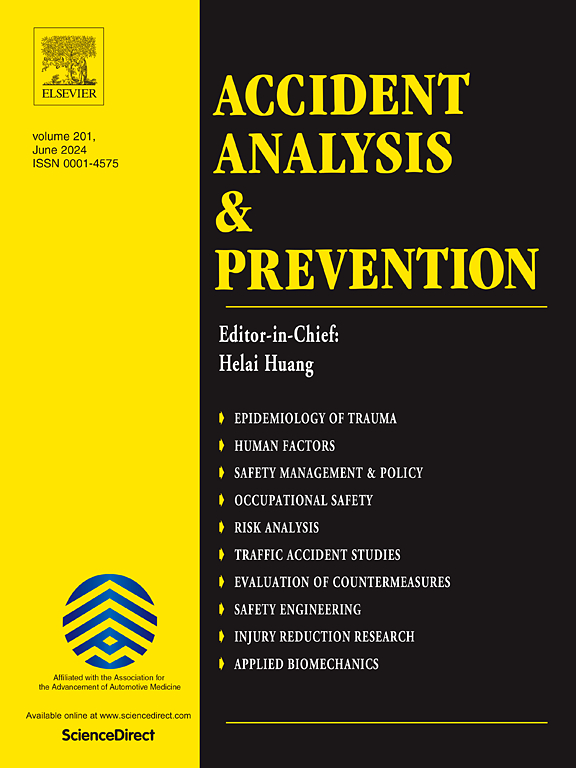Do motorists select safe routes over efficient routes? An empirical study using travel trajectory data
IF 5.7
1区 工程技术
Q1 ERGONOMICS
引用次数: 0
Abstract
Studies have highlighted the importance of traffic safety concerns in travelers’ mode choices. However, little attention has been given to route choices between safety and efficiency. This study aims to investigate motorists’ safety route choice behavior using vehicle trajectory data collected by the Automatic License Plate Recognition (ALPR) system in Changsha, China. A paired scenario comparison (PSC) method is proposed to examine motorists’ safety route choice behaviors by contrasting the choices under two scenarios across a large-scale city area. Specifically, four scenarios are considered, including daytime/nighttime, work/non-work, livelihood/non-livelihood, and short-distance/long-distance travel. Motorists’ route choice preferences are hypothesized to differ between paired scenarios. Motorists’ route choices are depicted by the Group Random Parameters Logit (GRPL) model with a set of route safety and efficiency attributes. Hypotheses are tested through an overall model validation and a series of scenario-specific model validations. Results demonstrate the significance of motorists’ priority of the routes with safety attributes (e.g., fewer intersections, wider roads) during nighttime trips or for non-livelihood purposes. However, evidence for work/non-work and trip distance effects remains inconclusive. This study provides empirical support for safety-oriented route planning and navigation systems.
驾驶者是否会选择安全路线而非高效路线?基于旅行轨迹数据的实证研究
研究强调了交通安全在旅行者模式选择中的重要性。然而,很少有人关注安全与效率之间的路线选择。利用车牌自动识别(ALPR)系统采集的车辆轨迹数据,研究长沙市汽车驾驶人的安全路线选择行为。提出了一种配对情景比较(PSC)方法,通过对比两种情景下驾驶员的安全路线选择行为,研究驾驶员的安全路线选择行为。具体来说,考虑了四种场景,包括白天/夜间、工作/非工作、生计/非生计、短途/长途旅行。假设驾驶者的路线选择偏好在配对场景中有所不同。通过组随机参数Logit (Group Random Parameters Logit, GRPL)模型描述驾驶者的路线选择,该模型具有一组路线安全和效率属性。通过整体模型验证和一系列特定于场景的模型验证来测试假设。结果表明,驾驶员在夜间出行或非生计目的时优先考虑具有安全属性的路线(如较少的交叉口,较宽的道路)的重要性。然而,工作/非工作和旅行距离影响的证据仍然没有定论。本研究为安全导向的路线规划与导航系统提供了实证支持。
本文章由计算机程序翻译,如有差异,请以英文原文为准。
求助全文
约1分钟内获得全文
求助全文
来源期刊

Accident; analysis and prevention
Multiple-
CiteScore
11.90
自引率
16.90%
发文量
264
审稿时长
48 days
期刊介绍:
Accident Analysis & Prevention provides wide coverage of the general areas relating to accidental injury and damage, including the pre-injury and immediate post-injury phases. Published papers deal with medical, legal, economic, educational, behavioral, theoretical or empirical aspects of transportation accidents, as well as with accidents at other sites. Selected topics within the scope of the Journal may include: studies of human, environmental and vehicular factors influencing the occurrence, type and severity of accidents and injury; the design, implementation and evaluation of countermeasures; biomechanics of impact and human tolerance limits to injury; modelling and statistical analysis of accident data; policy, planning and decision-making in safety.
 求助内容:
求助内容: 应助结果提醒方式:
应助结果提醒方式:


